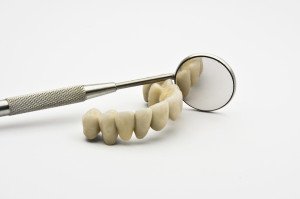Benefits And Types Of Dental Bridges
 When you think about it, dental bridges are appropriately named as such because they bridge the gap that one or more missing teeth has created. Bridges are usually constructed of two or more crowns that act as anchors and are called “abutment” teeth. They are usually situated on both sides of the gap created by the missing tooth or teeth and there is a false tooth known as a “pontic” in between them. The pontic is usually made from one of several materials such as alloys, gold, porcelain, or a combination of these. In most cases, a dental bridge will be supported by implants or a person’s natural teeth.
When you think about it, dental bridges are appropriately named as such because they bridge the gap that one or more missing teeth has created. Bridges are usually constructed of two or more crowns that act as anchors and are called “abutment” teeth. They are usually situated on both sides of the gap created by the missing tooth or teeth and there is a false tooth known as a “pontic” in between them. The pontic is usually made from one of several materials such as alloys, gold, porcelain, or a combination of these. In most cases, a dental bridge will be supported by implants or a person’s natural teeth.
Benefits Of Dental Bridges
Compared to traditional dentures, dental bridges are permanently affixed in place and not meant to be removed. In addition to being permanent in nature, there are a number of other benefits that dental bridges provide such as:
- By replacing missing teeth, dental bridges distribute biting power equally
- Enabling the wearer to chew and speak properly
- Helps to maintain facial shape
- Promotes the health of your remaining teeth
- Remaining teeth are not prone to drifting out of place
- Restoring one’s smile
Dental bridges are just one of the many services we offer at Community Dental Group. The only reason that a dental bridge would need to be removed is if a problem existed such as the decaying of the teeth surrounding the prosthetic.
Types Of Dental Bridges
Before making the decision to get a dental bridge, Community Dental Group advises that you learn and understand the 3 types that are available. These include:
Cantilever bridges – this particular type is commonly used when the patient has remaining teeth adjacent to the bridge on only one side of the gap created by the missing tooth/teeth. This type of dental bridge is rarely used anymore.
Maryland-bonded bridges – these are also known as a Maryland or resin-bonded bridge. They are typically made using a metal or porcelain framework that supports a person’s plastic gums and teeth. However, they are oftentimes made of porcelain or porcelain that has been fused to metal.
Traditional bridges – with this type of dental bridge, a crown for the implant or tooth is created on both sides of the gap created by the missing tooth/teeth while a pontic is placed in between them. They are typically made by fusing porcelain to ceramic or metal materials and are the most common type of dental bridges in use today.